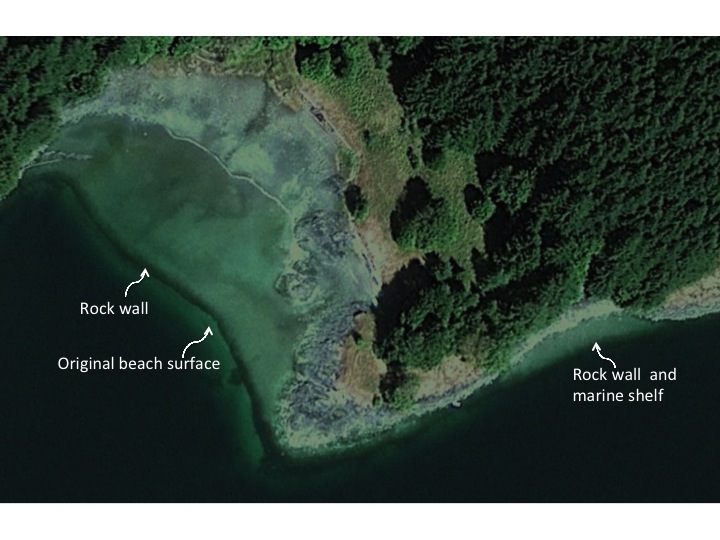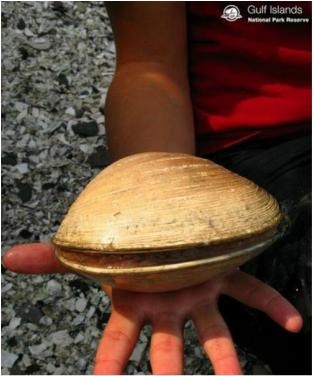 Friday - January 10, 2020
Friday - January 10, 2020
Ancient Tidal Farming
Study: Paleo Clam Gardens More Productive Than Natural Mud Flats
Well duh. That’s the whole idea of farming, right?
Yeah, I’m weird. This kind of stuff interests me. We’ve all read those articles about how anthropologists have found evidence of ancient First Peoples by the shell midden heaps they left everywhere. I guess the idea was that them old injuns would walk around every year or two to some productive spot by the water’s edge, and chow down on clams and oysters, toss the shells in a pile, and move on. And lather, rinse, repeat, for thousands of years. “Move to where the food is” is a great idea.
Well, it turns out that in some places, at least the Pacific northwest, folks had been doing aquaculture for thousands and thousands of years. At least as far back as the end of the last Ice Age.
Changing the very shape of the seashore by building and maintaining clam gardens. Clam gardens? What are they? Let’s go right to the PNAS and find out.
That Extra Special Human | Clam Relationship
Our understanding of the historical ecology of humans and butter clams on Quadra Island not only illustrates the long-term and intertwined relationships of these 2 species but also, serves as a model for studying the intricacies of other human–species relationships. In the case of butter clams, a culturally valued species, there was a myriad of ecological and cultural factors that influenced population viability throughout the Holocene.
...
On the Northwest Coast of North America, as in coastal communities worldwide, the human–clam relationship is age old and continues today. Tracing that history and situating these relationships in the context of modern management decisions take bringing together data from multiple sources and using diverse types of analyses. They also require recognizing the sometimes-active role of humans in modifying coastal ecosystems of the past as well as the present and that not all long-term human–ecological interactions have negative ecological consequences on biological diversity.
In our study area, our analyses of shells from intertidal death assemblages, archaeological shell middens, and modern clams provide insights into how clams, clam habitats, and human–clam relationships changed through time in a specific place. More specifically, the analyses reveal how clam life histories have responded to shifts in harvesting, habitat alterations, climate and environmental factors, and management practices. Taken together, the temporal and spatial variability that we document is another reminder of the need to gather site- and time-specific baselines for modern management. We have demonstrated that ocean temperatures and substrate play a role in butter clam life history. Thus, it is no surprise that there is considerable variation in estimates of butter clam size in the literature (46⇓⇓–49), just as there are in our modern data and paleodata. Management plans based on local, modern, and paleoecological data are likely to be more robust than those based on more general spatiotemporal data from the literature. However, under future climate change scenarios, environmental variables are likely to resort in different combinations than those of recent history and perhaps, with few analogs in the past.
Previous research on clam gardens in our study area demonstrated that clam gardens today are at least twice as productive as nonwalled beaches. This has implications for the numbers of people who can be locally supported by this ancient innovation in mariculture. Our data, however, show that clams in clam gardens today are far less productive than they were before European contact and industrial logging—that is, when traditional management systems were active and shell–sand–gravel vs. silt-rich beaches dominated clam habitats. This highlights the possibility that, if traditional mariculture methods were applied to clam beaches today, they could produce even greater yields than those estimated based on current ecological conditions—assuming similar pelagic production and oceanic conditions. In fact, many Indigenous communities along the Pacific Northwest Coast are exercising their rights to access and collective choice by restoring clam gardens and the traditional protocols associated with them.
Paleo Pete and Holocene Harry built up low walls of barely submerged stone across mud flat beaches at the low tide line. When the tide would rise, fresh silt and nutrients would wash in, but stay there when the tide went out, filtering through the loose stone walls. This made a perfect clam habitat.
In time the accumulation of silt changed the slope of the beach, flattening it out and growing the land. Clams thrived in this protected environment. People would come in and harvest them, safe behind the walls in the water. The more big clams they dug up and ate, the more room there was for the little clams to grow. Pretty soon you had clams enough for the multitudes, and some of these clam gardens stretched for miles. There are thousands of them along the coast, from Alaska down to Washington. And that’s the ones we can find today. How many more were lost beneath the waves as the post-glacial oceans slowly rose?

Indigenous people of the west coast of North America used a range of techniques and practices to maintain or increase the production of culturally important foods, including clams. These practices are encompassed within age-old social, economic, and spiritual beliefs and practices of coastal First Peoples. One long-lasting and visible practice was the building of clam gardens.
Clam gardens are ancient intertidal features constructed by the coastal First Nations of British Columbia (Canada) and Native Americans of Washington State and Alaska (USA), to enhance shellfish productivity. These features are made by constructing rock walls at the low tide line along the edges of bays and inlets, transforming naturally sloping beaches or rocky shorelines into productive, level beach terraces.
Coastal First Nations knowledge holders note that the very act of harvesting clams keeps clam beaches productive. Digging for clams creates healthy bivalve habitat by turning over the beach sands and silts, exposing these sediments to oxygen. In an unworked beach, seaweed and dead clams can accumulate on the surface of the beach, suffocating live clams. When digging, people ensured that populations were healthy by thinning clams or preferentially harvesting larger ones to allow younger clams to grow. We learned from Indigenous harvesters that some people added broken shells back to the beach to augment the sediments as needed.

Amy Groesbeck’s recent investigation into these ancient structures found that clams are more plentiful, and grow bigger inside of clam gardens. Butter clams are known to grow four times as big in clam gardens compared to non-walled beaches (Groesbeck et al, 2014). There is speculation that the rock walls could also provide a home for other creatures including young fish, sea cucumbers, and other invertebrate species. Current observations suggest that building clam gardens may change the types of species surrounding the clam garden, but will not likely have a harmful impact on the species already present.
Clam gardens have recently caught the attention of many academics, researchers, resource managers, and First Nations along the Vancouver coast – who has joined forces and formed “The Clam Garden Network”.
And you know what else? Clams fight both pollution and global warming. Well, the things are filter feeders, so they suck the yuck out of the ocean and live on it. And as clams grow, their shells grow. The shells are made of calcium carbonate. This means that clams reduce greenhouse gas by locking up huge amounts of carbon dioxide by building their shells. So they’re good for the environment. And good to eat.
Seriously, we don’t need to go all Greta and destroy our world to reduce our Evil Carbon Footprint. Just plant more trees, and farm clams and oysters. It’s organic. It’s sustainable. And it costs hardly a thing.
Posted by Drew458
Filed Under: • Archeology / Anthropology • Environment • Food • Gardens and plants •
• Comments (2)
Five Most Recent Trackbacks:
Once Again, The One And Only Post
(4 total trackbacks)
Tracked at iHaan.org
Th’Įģ advantage to having a guide with you is th╔æt an expert will hačĄe very first hand experience dealing and navigating the river with ą│egional wildlife. Tę╗omas, there are great…
On: 07/28/23 10:37
The Brownshirts: Partie Deux; These aare the Muscle We've Been Waiting For
(3 total trackbacks)
Tracked at head to the Momarms site
The Brownshirts: Partie Deux; These aare the Muscle We’ve Been Waiting For
On: 03/14/23 11:20
Vietnam Homecoming
(1 total trackbacks)
Tracked at Õ╣┐ÕæŖõĖōķóśķģŹķ¤│ õĖōõĖÜõ╗Äõ║ŗõĖŁµ¢ćķģŹķ¤│ĶĘ¤Õż¢µ¢ćķģŹķ¤│ÕłČķĆĀ’╝īÕīŚõ║¼ÕÉŹõ╝ĀÕż®õĖŗķģŹķ¤│Õģ¼ÕÅĖ
ŃĆĆŃĆĆõĖōõĖÜõ╗Äõ║ŗõĖŁµ¢ćķģŹķ¤│ÕÆīÕż¢µ¢ćķģŹķ¤│ÕłČõĮ£’╝īÕīŚõ║¼ÕÉŹõ╝ĀÕż®õĖŗķģŹķ¤│Õģ¼ÕÅĖ ŃĆĆŃĆĆÕīŚõ║¼ÕÉŹõ╝ĀÕż®õĖŗõĖōõĖÜķģŹķ¤│Õģ¼ÕÅĖµłÉńĀ┤õ║Ä2006Õ╣┤12µ£ł’╝īµś»õĖōõĖÜõ╗Äõ║ŗõĖŁ õĖŁµ¢ćķģŹķ¤│ µ¢ćķģŹķ¤│ĶĘ¤Õż¢µ¢ćķģŹķ¤│ńÜäķ¤│ķóæÕłČķĆĀÕģ¼ÕÅĖ’╝īÕ╣╗µā│ķŻ×ĶģŠķģŹķ¤│ńĮæķóå ķģŹķ¤│ÕłČõĮ£ µ£ēµĄĘÕåģÕż¢õ╝śĶē»õĖōõĖÜķģŹķ¤│ĶüīÕæśÕĘ▓ĶŠŠ500ÕżÜõĮŹ’╝īÕÅ»õŠøń╗ÖõĖƵĄüńÜäÕż¢Ķ»ŁķģŹķ¤│’╝īķĢ┐Õ╣┤µ£ŹÕŖĪõ║ÄÕøĮÕåģõĖŁÕ┐āń║¦ÕÉäÕż¦Õ¬ÆõĮōŃĆüÕÉäń£üÕĖéńöĄÕÅ░ńöĄĶ¦åÕÅ░’╝īĶāĮµ╗ĪµäÅõĖŹÕÉīÕ«óµłĘńÜäÕÉäń¦Źķ£ĆĶ”üŃĆéńöĄĶ»Ø’╝Ü010-83265555 ŃĆĆŃĆĆÕīŚõ║¼ÕÉŹõ╝ĀÕż®õĖŗõĖōõĖÜķģŹķ¤│Õģ¼ÕÅĖ…
On: 03/20/21 07:00
meaningless marching orders for a thousand travellers ... strife ahead ..
(1 total trackbacks)
Tracked at Casual Blog
[...] RTS. IF ANYTHING ON THIS WEBSITE IS CONSTRUED AS BEING CONTRARY TO THE LAWS APPL [...]
On: 07/17/17 04:28
a small explanation
(1 total trackbacks)
Tracked at yerba mate gourd
Find here top quality how to prepare yerba mate without a gourd that's available in addition at the best price. Get it now!
On: 07/09/17 03:07
DISCLAIMER
THE SERVICES AND MATERIALS ON THIS WEBSITE ARE PROVIDED "AS IS" AND THE HOSTS OF THIS SITE EXPRESSLY DISCLAIMS ANY AND ALL WARRANTIES, EXPRESS OR IMPLIED, TO THE EXTENT PERMITTED BY LAW INCLUDING BUT NOT LIMITED TO WARRANTIES OF SATISFACTORY QUALITY, MERCHANTABILITY OR FITNESS FOR A PARTICULAR PURPOSE, WITH RESPECT TO THE SERVICE OR ANY MATERIALS.
Not that very many people ever read this far down, but this blog was the creation of Allan Kelly and his friend Vilmar. Vilmar moved on to his own blog some time ago, and Allan ran this place alone until his sudden and unexpected death partway through 2006. We all miss him. A lot. Even though he is gone this site will always still be more than a little bit his. We who are left to carry on the BMEWS tradition owe him a great debt of gratitude, and we hope to be able to pay that back by following his last advice to us all:
It's been a long strange trip without you Skipper, but thanks for pointing us in the right direction and giving us a swift kick in the behind to get us going. Keep lookin' down on us, will ya? Thanks.
- Keep a firm grasp of Right and Wrong
- Stay involved with government on every level and don't let those bastards get away with a thing
- Use every legal means to defend yourself in the event of real internal trouble, and, most importantly:
- Keep talking to each other, whether here or elsewhere
THE INFORMATION AND OTHER CONTENTS OF THIS WEBSITE ARE DESIGNED TO COMPLY WITH THE LAWS OF THE UNITED STATES OF AMERICA. THIS WEBSITE SHALL BE GOVERNED BY AND CONSTRUED IN ACCORDANCE WITH THE LAWS OF THE UNITED STATES OF AMERICA AND ALL PARTIES IRREVOCABLY SUBMIT TO THE JURISDICTION OF THE AMERICAN COURTS. IF ANYTHING ON THIS WEBSITE IS CONSTRUED AS BEING CONTRARY TO THE LAWS APPLICABLE IN ANY OTHER COUNTRY, THEN THIS WEBSITE IS NOT INTENDED TO BE ACCESSED BY PERSONS FROM THAT COUNTRY AND ANY PERSONS WHO ARE SUBJECT TO SUCH LAWS SHALL NOT BE ENTITLED TO USE OUR SERVICES UNLESS THEY CAN SATISFY US THAT SUCH USE WOULD BE LAWFUL.
Copyright ┬® 2004-2015 Domain Owner
Oh, and here's some kind of visitor flag counter thingy. Hey, all the cool blogs have one, so I should too. The Visitors Online thingy up at the top doesn't count anything, but it looks neat. It had better, since I paid actual money for it.











